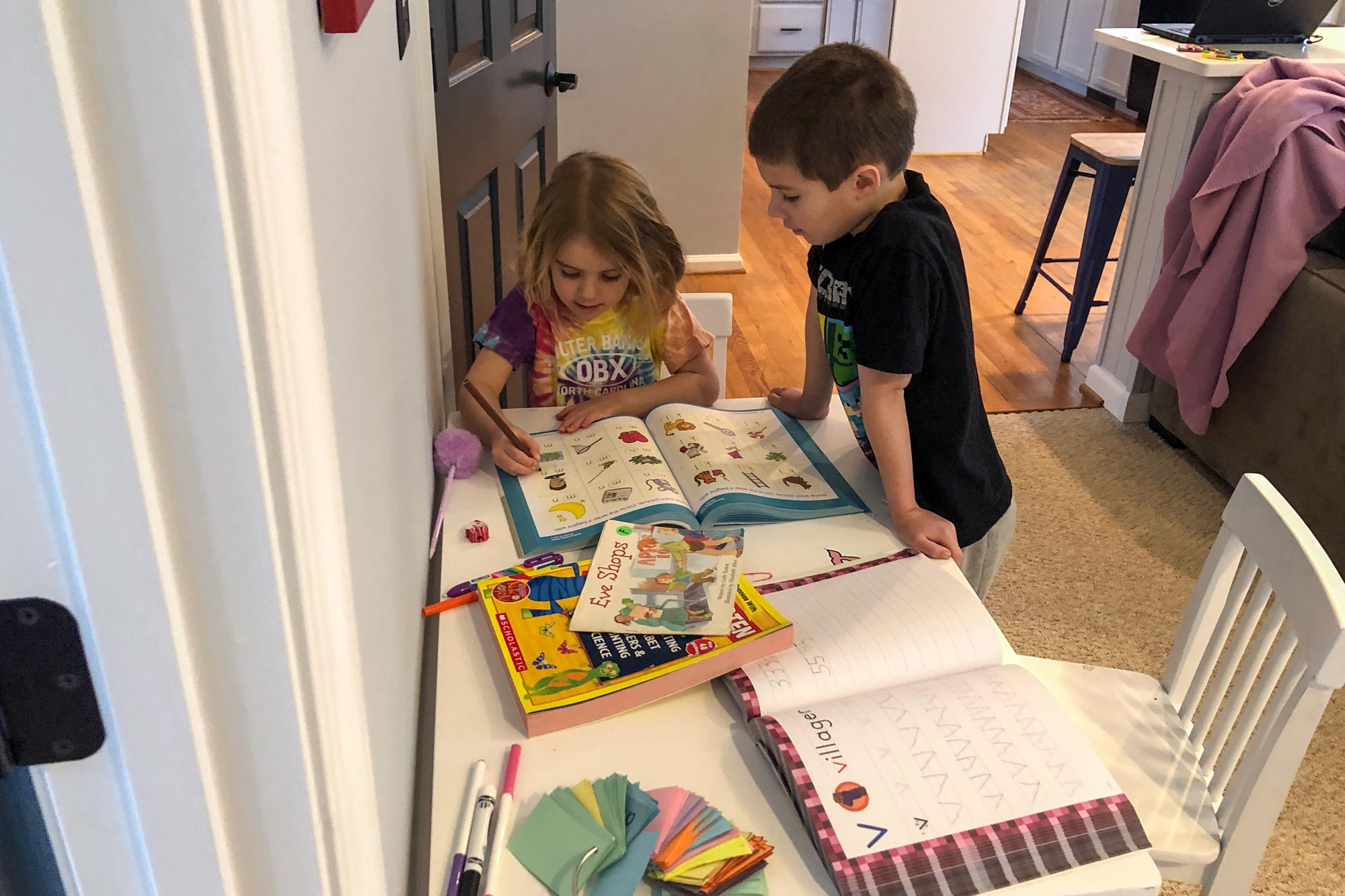Find the latest information on the University’s response to the coronavirus here.
Making a schedule, sticking to a routine, keeping things fun and interesting.
Yeah, it all sounds good on paper, right?
But many parents had a rude awakening on Monday when, due to the closure of schools caused by the COVID-19 pandemic, they were suddenly teachers and, simultaneously, trying to do their own work from home.
UVA Today turned to Gail Lovette, an assistant professor in the University of Virginia’s Curry School of Education and Human Development – who has three young children – for a life raft … er, guidance.
“It is so hard to parent, teach and also work a full-time job,” said Lovette, who has an 8-, a 6- and a 4-year-old. “It’s virtually impossible, actually.
“I have two pieces of advice: The first is to lower your expectations for yourself and for your kids. The second is to triage your tasks and set a very strategic schedule for yourself and for them. The younger your kids are, the harder this going to be because, developmentally, they’re not able to work as independently.
“My 4-year-old said to me this morning, ‘If you’re my teacher, will you still be my mom?’ So it can be hard to cross boundaries in your relationships with your kids. I would say the more you talk to your kids ahead of time about the schedule and what needs to be accomplished, the better.”
Here are some more tips:
Set Realistic Goals
Lovette believes that if you don’t set realistic goals for both you and your kids, you’ll “crash and burn early.”
“Unlike a snow day, where it’s just a couple days and you can make it work, this is going to go on for who knows how long,” she said.
“I would say use Alexa if you have one to take music and listening breaks and build in activity breaks for everyone. I’m used to putting my head down and writing for eight hours or working on a research project or teaching my class, but that’s just not going to be feasible anymore.

Setting realistic goals for both yourself and your kids is key, according to Curry School assistant professor Gail Lovette. (Photo by Dan Addison, University Communications)
“Scheduling activity breaks for yourself and your kids so that you set realistic goals is so important. For a 4-year-old, you probably need to work in 20-minute increments. My second-grader, I can probably push for 45 minutes to an hour. But even in school classrooms, kids aren’t sitting for a very long amount of time. They’re getting up, walking around, transitioning – so it’s not realistic to expect them to sit at your dining room table for two hours.
“I’ve seen schedules floating around right now that are like hourlong blocks. That’s maybe realistic for fifth- or sixth-graders, but probably not for most younger kids.”
Structuring and Incentivizing
“For those of us who don’t really work on a set schedule and are used to being able to prioritize and strategize our day in a way that fits for us – we can’t do that anymore,” Lovette said. “Just like we’re going to sit down and schedule our kids, we’re also going to need to schedule our own most productive times, and then it’s like a game of Tetris where we have to plug it in to work with them.
“You can also use a visual schedule, especially for younger kids or kids who benefit from more structure. That takes a lot of the unpredictability out of the day. Use pictures or post-it notes that you can move around with them in the morning to lay out the rest of your day. Giving them some forced choice – like, ‘From 10 to 10:15. you can choose either reading, doing an art project, or playing with Legos’ – will help them to feel like they have some control in this situation.
“When you walk into any day care facility or school, they will have their schedule posted and that gives kids the structure they need. My 4-year old told me today that I was doing it wrong because nap happens right after lunch.
“I would also think about using an ‘If-Then’ chart if your children are struggling with the new schedule. For example, if you do 20 minutes of reading, then you get 10 minutes of whatever activity. Build in strong incentives for them to attend to the tasks on the schedule.”
Finally, things are likely to change on a daily basis, especially with young kids.
“Right now, I am scheduling on a day-by-day basis. With a 4-year-old, what worked yesterday will probably not work tomorrow. So, I am hoping to learn from each day to help me craft the next one with all three of my kids. Although there are some things that I will keep at the same time every day.”
Lovette continued, “As much as you can keep lunchtime the same in your house, that’s going to help. Some kids eat lunch at 10:30 in the morning. Those of us who work at a desk will eat lunch whenever we’re hungry – so we need to be more strategic about our own schedules as well.”v
Limit Snacks
“Kids act like they’re out on the frontier foraging for food and starving when they’re at home all day,” Lovette said, with a chuckle. “For my kids at least, it’s like every five minutes they act like they’re going to die from starvation unless they get a snack. Four hundred snacks later …
“Schools don’t do that. You can’t graze the whole day at school. So, I would build a few snack times into whatever schedule you have created.”
Activities for Kids
A plethora of online learning activities is circulating on social media. Many companies are offering free access to their learning software and authors are hosting real-time read-alouds.
But what about the toddler pulling on your leg all day?
Lovette said sorting objects can be a great activity for preschool-aged children because it allows them to work independently while you’re trying to work. “You could take a baking sheet and put a bunch of Legos on there or any kind of small object and have them sort it while you’re sitting next to them working,” she said. “That can usually take a lot of time.”
“For grades two and up, one thing I think is really interesting is having them keep a daily journal because when we all look back, this is an unprecedented time in our history for everyone. Who knows how this is going to play out, but that journal will be fascinating when they’re talking to their own kids about this time someday. It’ll be a great primary source.
“Another thing I’m encouraging my kids to do is to write letters or make cards for people in nursing homes or hospitals who can’t have visitors right now. They can still get mail.”
FaceTime with Friends
Lovette said the Apple videochat feature can be a great tool.
“Kids are very social learners, so one recommendation I would have is to keep them connected with their friends through FaceTime,” she said. “FaceTime or video calling is an amazing thing we have at our disposal now. Your kids can FaceTime with a friend or a couple of friends and read books with them. Or if they’re younger, just do a group chat so that they’re still getting that socialization and talking about what they’re learning and doing each day.”
Be Strategic About Screen Time
Lovette said parents should be aware of the two types of screen time: interactive and passive.
“Interactive screen time is when they’re playing an educational game or watching a read-aloud and answering questions,” Lovette said. “For parents, that’s more hands-on, versus passive screen time, which is when they’re watching a show or a movie or playing a video game. You’ll want to use passive screen time judiciously.
“For me, if I have a Zoom call or something that I have to get done where the kids just absolutely cannot interrupt, I’m going to use some passive screen time for that.”
Meeting From Home Etiquette … for Kids
Even if you plug your kids into a show while you are on an important meeting or call, the kids may not recognize that it is not the best time to ask you for that 97th snack.
“Sit down with your kids ahead of time and spell out expectations for them for when Mom or Dad is on the phone or on a web-call,” Lovette suggested. “Give them three things they can do until you’re done. Tell them ahead of time that if Mom or Dad is on the phone or meeting on the computer, then you can do any of these three things until we are off. It’s non-negotiable. That’s non-interrupting time. And provide incentives for following those directions.
“Also, interruptions will happen as we are all navigating this new dynamic and space. When they do, use that as a learning opportunity for everyone for the next time. And maybe a time for some much-needed levity.”
Reading Time
As you would expect, Lovette said there’s no such thing as reading to and with your kids too much.
“Be purposeful about it,” she said. “Set time for it every day, which may include having to shift your own working schedule. For older kids, they may be able to read independently, but still check in with them and have some conversations with them about what they are reading. For younger kids, read to them and make it interactive and fun.
“One thing I would recommend is that if you were planning on starting a series with your kids, like ‘Harry Potter,’ this is a great time to do it! You may get through the whole series!”
Patience
Patience while navigating this new working environment can, like toilet paper, be in short supply.
“We may have to let go of some things or schedule our most important tasks for later in the evening after the kids are in bed to allow us to be fully present for both our work and our family,” Lovette said.
“Most importantly,” she said, “this is different for everyone right now and we will all benefit from an abundance of patience – with ourselves, our children and our colleagues. Potentially, this first week will be kind of rough on everyone. Dig deep. Set small goals.”
Media Contact
Article Information
March 18, 2020
/content/how-get-your-kids-do-their-schoolwork-while-getting-your-own-work-done

